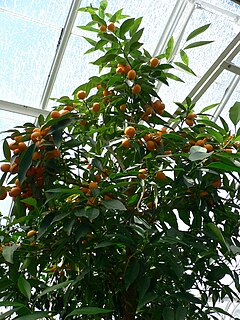
Jungermanniales is the largest order of liverworts. They are distinctive among the liverworts for having thin leaf-like flaps on either side of the stem. Most other liverworts are thalloid, with no leaves.

Jungermanniopsida is the largest of three classes within the division Marchantiophyta (liverworts).
The putative Wych Elm cultivar Ulmus glabra 'Holgeri' originated in Sweden, where it was described by Holger Jensen of Ramlösa Plantskola, Helsingborg, in 1921. It was distributed by the Späth nursery of Berlin in the 1920s and '30s as Ulmus montana Holgeri. Späth used U. montana both for wych and for U. × hollandica hybrids like 'Dampieri', so the name does not necessarily imply a wych cultivar. In The Netherlands the tree was classified as an Ulmus × hollandica hybrid, a 1932 herbarium specimen from a tree in The Hague supplied by Späth being labelled Ulmus hollandica var. holgeri (Jensen).
Charles Baron Clarke was a British botanist. He was born at Andover, the eldest son of Turner Poulter Clarke. He was educated at King's College School, London, and at Trinity and Queens' Colleges, Cambridge. He began the study of law at Lincoln's Inn in 1856 and was called to the bar in 1860. He lectured in mathematics at Presidency College, Calcutta, from 1857 to 1865. Clarke was Inspector of Schools in Eastern Bengal and later of India, and superintendent of the Calcutta Botanical Garden from 1869 to 1871. He retired from the Indian Civil Service in 1887. He was president of the Linnean Society from 1894 to 1896, and was elected a fellow of the Royal Society in 1882. He worked at Royal Botanic Gardens Kew until his death in 1906.
Charles Isidore Douin was a French bryologist who was a native of Bouville, Eure-et-Loir.

Cunninghamella is a genus of fungi in the order Mucorales, and the family Cunninghamellaceae. The genus was circumscribed by French mycologist Alphonse Louis Paul Matruchot in Ann. Mycol. Vol.1 on page 47 in 1903.
Ludwig Benjamin (1825–48) was a German botanist who contributed to Carl Friedrich Philipp von Martius' Flora Brasiliensis. The genus Benjaminia is named in his honour.

Clymenia is a small genus of flowering plants in the family Rutaceae with two species. The genus is often included in Citrus.

William Louis "Bill" Culberson was an American lichenologist.
Chimaerochloa is a genus of New Guinean plants in the grass family.
Schljakovia is a monotypic genus of liverworts belonging to the family Anastrophyllaceae. The only species is Schljakovia kunzeana.
Conardia is a genus of mosses belonging to the family Amblystegiaceae.
Lophoziopsis is a genus of liverworts belonging to the family Lophoziaceae.
Ampelosicyos is a genus of flowering plants belonging to the family Cucurbitaceae.
Detonula is a genus of diatoms belonging to the family Thalassiosiraceae.
Anastrophyllaceae is a family of liverworts belonging to the order Jungermanniales.
Neobuchia is a monotypic genus of flowering plants belonging to the family Malvaceae. It only contains one known species, Neobuchia paulinaeUrb.

Pauldopia is a monotypic genus of flowering plants belonging to the family Bignoniaceae. It only contains one known species, Pauldopia ghonta(Buch.-Ham. ex G.Don) Steenis
Drusa is a monotypic genus of flowering plants belonging to the family Apiaceae. It has one known species, Drusa glandulosa(Poir.) H.Wolff ex Engl.





